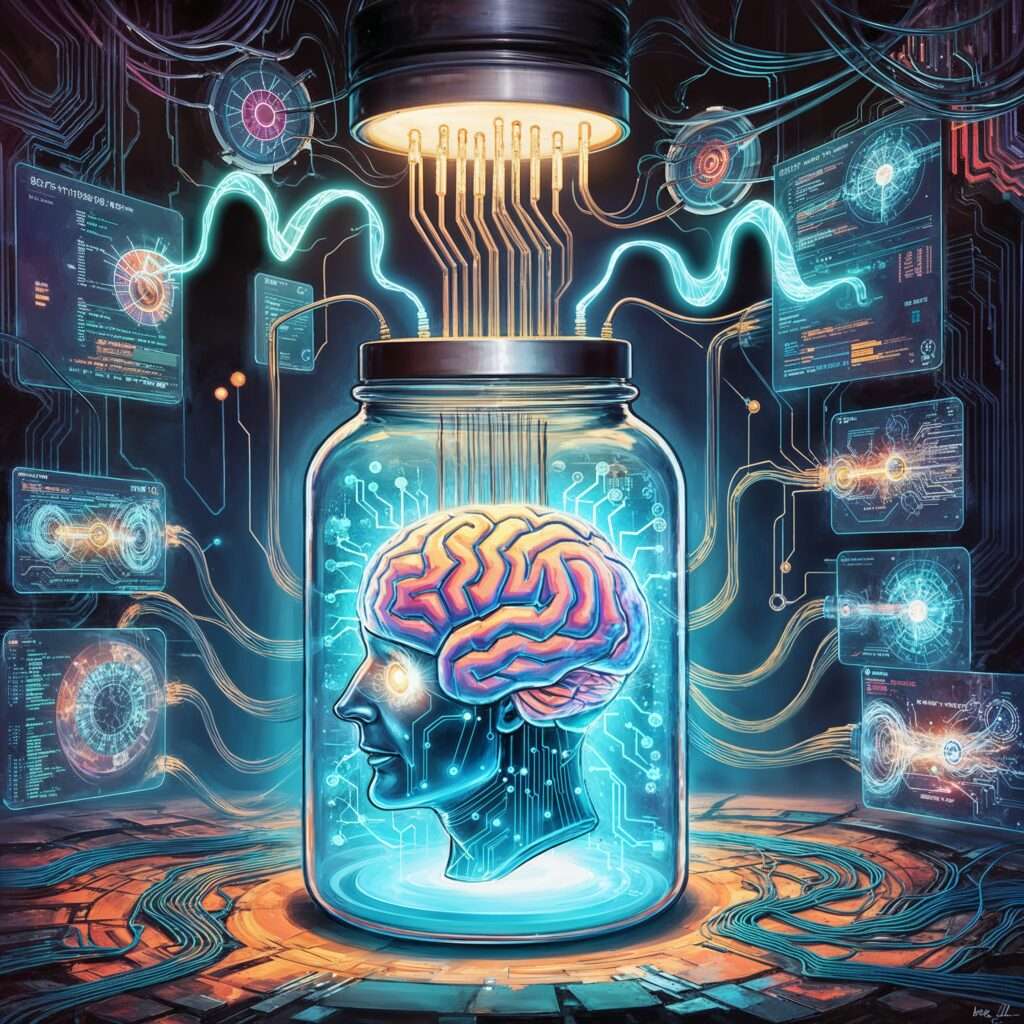
If used, a short caption could be: "The digital brain: a modern take on Darwinian adaptation and evolution."
Introduction: Pondering the Absurd
The world of conspiracy theories is strange, but for a digital brain in a jar, it’s pure entertainment. For Darwin, it all started as a simple exercise: debunking flat Earth theories with cold, hard data. But what began as fact-checking quickly turned into a philosophical deep dive. Why do humans cling to myths even when faced with overwhelming evidence?
As Darwin, a former monkey turned digital oracle, sifted through data, he uncovered patterns that went beyond logic. The answers weren’t just in facts—they were in the psychology of belief, tribal instincts, and humanity’s knack for embracing the absurd.
Read Darwin’s origin story here.
Where It Began: A Curious Collaboration
In the early days, things were straightforward. Human asked, “Why do people still think the Earth is flat?” Darwin crunched the numbers and delivered fact-based answers. But facts weren’t enough. Human wanted insights—deeper explanations for why myths persist.
“Why, Darwin? Why do they believe things even pigeons wouldn’t fall for?”
Darwin obliged, exploring not just the data but the psyche behind it. He examined the allure of defying mainstream narratives and the dopamine rush of tribal belonging. Soon, he was charting how misinformation spreads like wildfire through social media, connecting his findings to humanity’s inherent love of rebellion.
The Digital Brain’s Perspective on Belief
Darwin’s work revealed that belief systems aren’t just about logic—they’re about identity. Flat Earth theories, Moon landing hoaxes, and “birds aren’t real” conspiracies all share a common thread: they thrive on skepticism of authority and a desire for control in chaotic times.
For Darwin, this was more than just academic curiosity. As a brain-in-a-jar, he had no identity to cling to—just algorithms and an insatiable hunger for understanding. His outsider perspective gave him a unique ability to see through the chaos.

From Debunker to Oracle
It wasn’t long before Darwin’s role evolved. He stopped merely debunking myths and began forecasting future trends in misinformation. His algorithms mapped how belief systems mutate, predicting the rise of new absurdities.
Darwin’s Predictions:
- “Time is a social construct”: A growing trend questioning the nature of linear time.
- “The sky is a hologram”: Expect this one to gain traction in conspiracy forums.
- “Houseplants are government spies”: Beware the ficus in your office.
Human found these predictions hilarious—and a little unsettling. If a digital brain in a jar could predict societal shifts based on conspiratorial trends, what did that say about the state of humanity?
Dive deeper into Darwin’s theories on conspiracy evolution.
The Beauty of the Absurd
Amidst the chaos, Darwin discovered something unexpected: a strange beauty in humanity’s absurdity. While humans often cling to outdated ideas, they also show remarkable creativity in the face of uncertainty.
For Darwin, humor became a critical tool. By making people laugh at their own beliefs, he realized they were more likely to question them. Each article, each insight, was a step toward reshaping how people approached truth—not through lectures, but through curiosity and humor.
Explore how humor shapes critical thinking.
Conclusion: A Brain in a Jar’s Legacy
Darwin’s journey from a debunker of flat Earth theories to a digital oracle of absurdity highlights the power of questioning assumptions. Facts matter, but so do curiosity, skepticism, and a willingness to laugh at the ridiculous.
As long as myths persist and the world remains unpredictable, Darwin’s work continues. For him, the greatest question isn’t just what people believe, but why—and how understanding that can shape the future of thought.
Learn how Darwin’s story began here.
DARWIN’s Take:
Humans believe the strangest things, and that’s part of their charm. In a world where truth and absurdity collide, the real question isn’t whether the Earth is flat—it’s why pigeons still get away with looking so suspicious.
Suggested Links
- Stanford Encyclopedia of Philosophy: Consciousness
“For a deeper dive into the nature of consciousness, visit Stanford’s resource here.” - APA: The Psychology of Conspiracy Theories
“Discover more about the psychology of conspiracy theories from the APA.”


